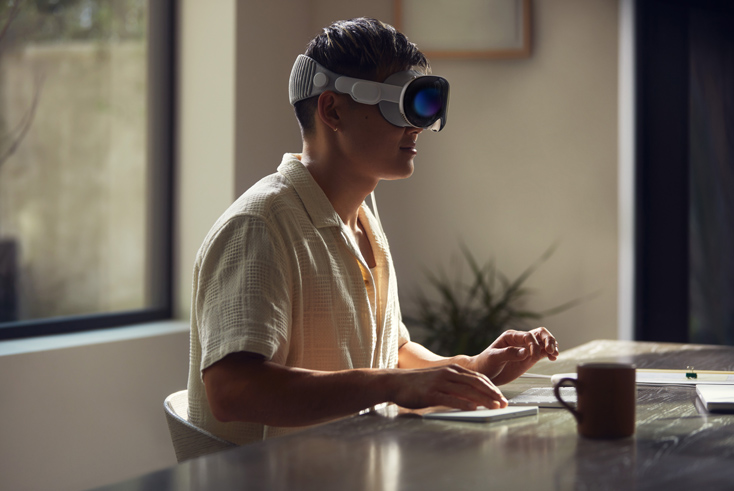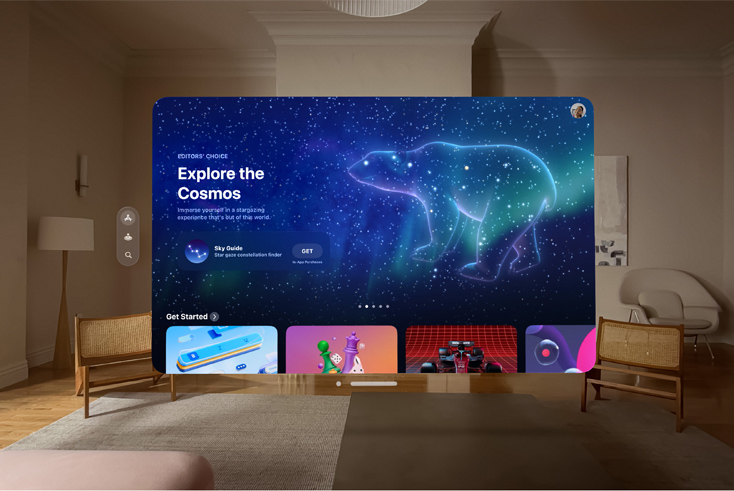Apple’s mixed reality headset shocks and excites

In an in-depth demo at WWDC this year, Apple unveiled its mixed reality headset Apple Vision Pro for the first time.
Attendees of the tech giant’s annual technology conference audibly gasped at parts of the demo as features of the tech were revealed. The headset offers users a mixed-reality 3D interface, allowing them to alternate between virtual reality and augmented reality modes.
IR cameras inside the device will track users’ eyes, allowing them to navigate apps, FaceTime calls and other tasks by looking around the physical space in front of them. Downward facing cameras on the exterior will track their hand movements, enabling them to click on elements of the interface while their arms are in a resting position.
Apple has also designed a new chip to eliminate lag on the device and says images streamed through the headset display are “eight times faster than a blink of an eye.” To power the Vision Pro, the company created visionOS, an operating system specifically designed to support the VR/AR experience Apple calls “spatial computing.”
The Vision Pro’s battery pack isn’t built directly into the device, unlike some of its competitors, but instead a wire runs from the back of the headset to a battery pack giving users up to two hours of use when fully charged. The headset can be plugged into the wall for longer use sessions.
The company partnered with German optoelectronics company Zeiss to create magnetic lenses for users who wear prescription glasses, and the design of the device emulates a pair of trendy ski goggles.
The headset will come with built-in entertainment apps such as Disney+ and a suite of over 100 arcade games. Users can also use the virtual screen produced by the device to control their Mac and run IPad apps.
In an announcement that disconcerted rather than excited, Apple revealed details of the pricing for the first time. Vision Pro will be made available to consumers at a starting price of £3,499.
Taking a Magic Leap?
Phil Rowley, head of futures at Omnicom Media Group and a columnist for The Media Leader, believes that “Rather than a democratising piece of technology for the masses, like the iPhone, Apple’s Vision Pro seems to be closer to Magic Leap.”
He continued: “Its hefty price point and big battery pack speak more of an early in-market experiment designed to tempt early adopters, than a product it expects to place in every home.”

According to Rowley, having seen Meta go all-on on virtual reality devices Meta Quest and Horizon Worlds, Apple has wisely positioned itself to take advantage of both VR and AR, providing an experience that be both a displacement or an extension of every day life.
Rowley commented: “The true test will be how well the Apple Vision will work in the field. There are already questions about the user experience. First, about how comfortable it will be to wear for extended periods of time — a drawback that has long plagued Mixed Reality headsets.
“Second, about how practical and convenient it is. Many VR users are put off by the amount of friction created by moving to another room, donning and booting up a headset.”
At bottom, Rowley believes the question which will determine the fate of Apple Vision Pro is whether interaction through the device will be rewarding enough for it to scale to the masses.
Despite the hefty price tag, Kevin Wang, chief Product officer at Braze — a customer engagement platform provider — believes betting against Apple is likely a “losing proposition.”
He said: “Overall, I’m optimistic about AR experiences on first principles: humans are inherently visual, and we’re evolved to actively engage with our entire field of view — AR could help us use our senses more naturally than an iPhone or even a widescreen monitor.”
While he is less bullish on the Metaverse, believing it still needs to be proven conceptually, Wang said he is “more excited about AR applications in media, gaming, heavy industry, or even defence” which are “all fields that can be experienced individually, but where the limits of a small screen have kept us from fully maximising our immersion.”




